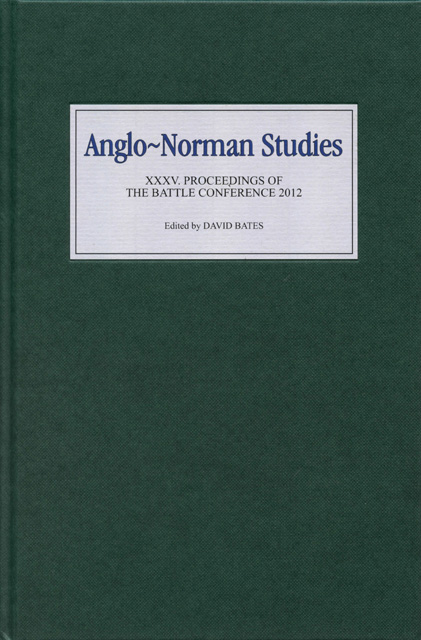Book contents
- Frontmatter
- Dedication
- Contents
- List of Illustrations and Tables
- Editor’s Preface
- Abbreviations
- A Three-Cornered Dynamic of Redemption in the ‘Long’ Thirteenth Century: Villein Manumissions and the Theology of the Incarnation (The R. Allen Brown Memorial Lecture, 2011)
- Femmes en religion, personnes d’autorité: les abbesses normandes (XIe–XIIIe siècles) (The R. Allen Brown Memorial Lecture, 2012)
- The Role of the Curator of the Bayeux Tapestry
- Early Normandy
- The Norman Conquest, Countess Adela, and Abbot Baudri
- Baldric of Bourgueil and the Flawed Hero
- John Bilson (1856–1943) and the Study of Anglo-Norman Romanesque
- The Identity of the Designer of the Bayeux Tapestry
- The Pseudo-Hugh Falcandus in His Own Texts
- The Thirteenth-Century Chronique de Normandie
- Les investitures abbatiales en Normandie: quelques réflexions autour du cas de l’abbaye du Bec-Hellouin (1034–1136)
- Robert Curthose: The Duke Who Lost His Trousers
- Sufficientia: A Horatian Topos and the Boundaries of the Self in Three Twelfth-Century Poems
- Aristocratic Acta in Normandy and England, c. 1150–c. 1250: The Charters and Letters of the Du Hommet Constables of Normandy
- Crime without Punishment: Medieval Scottish Law in Comparative Perspective
- Landscape and Belief in Anglo-Norman England
- Contents of Volumes 1–34
The Norman Conquest, Countess Adela, and Abbot Baudri
Published online by Cambridge University Press: 28 February 2023
- Frontmatter
- Dedication
- Contents
- List of Illustrations and Tables
- Editor’s Preface
- Abbreviations
- A Three-Cornered Dynamic of Redemption in the ‘Long’ Thirteenth Century: Villein Manumissions and the Theology of the Incarnation (The R. Allen Brown Memorial Lecture, 2011)
- Femmes en religion, personnes d’autorité: les abbesses normandes (XIe–XIIIe siècles) (The R. Allen Brown Memorial Lecture, 2012)
- The Role of the Curator of the Bayeux Tapestry
- Early Normandy
- The Norman Conquest, Countess Adela, and Abbot Baudri
- Baldric of Bourgueil and the Flawed Hero
- John Bilson (1856–1943) and the Study of Anglo-Norman Romanesque
- The Identity of the Designer of the Bayeux Tapestry
- The Pseudo-Hugh Falcandus in His Own Texts
- The Thirteenth-Century Chronique de Normandie
- Les investitures abbatiales en Normandie: quelques réflexions autour du cas de l’abbaye du Bec-Hellouin (1034–1136)
- Robert Curthose: The Duke Who Lost His Trousers
- Sufficientia: A Horatian Topos and the Boundaries of the Self in Three Twelfth-Century Poems
- Aristocratic Acta in Normandy and England, c. 1150–c. 1250: The Charters and Letters of the Du Hommet Constables of Normandy
- Crime without Punishment: Medieval Scottish Law in Comparative Perspective
- Landscape and Belief in Anglo-Norman England
- Contents of Volumes 1–34
Summary
Much is still controversial regarding the Norman conquest of England. Among important contested matters are the respective sizes of the forces deployed by Duke William and King Harold at Hastings. The traditional view that William’s army numbered in the 7,000 range rests on neither a contemporary nor a later source, and in my opinion it is untenable. By contrast, the Chronicle of Saint-Maixent provides a figure in the neighbourhood of 14,000 men for William’s total force. This is the only figure in any source that is not absurdly large. More importantly, the Chronicle was patronized by the court of Viscount Aimeri of Thouars in whose mouvance the monastery of St Maixent was to be found. The grandfather of the patron, also named Aimeri and also viscount of Thouars, played a leadership role at the battle of Hastings and was a major adviser to the Norman duke on the eve of his coronation as king of the English. In addition, the elder Aimeri was married to Ainor, William the Conqueror’s sister.
Obviously, in the wake of the Norman conquest, the family of the viscounts of Thouars and those men who served in their military households during the decades after Hastings had a far better opportunity than most to have accurate information regarding the size of William’s army. The men of Thouars, whose telling and retelling of their experiences became part of the historical memory of the viscomital court, later to be recorded in the Chronicle, had no reason to exaggerate in an upward manner the size of the Conqueror’s forces. Traditionally, among writers in both the ancient and the medieval West, the greater glory was regarded as going to a comparatively small force that defeated a larger one. If the Chronicle were to have been exaggerating, the likelihood was that it would have provided a dramatically lower figure for William’s army.
Regarding William’s effectives at Hastings, perhaps as many as 1,000 men were deployed at Pevensey to hold the fortifications there. Other troops were deployed to guard the fortifications at Hastings. In addition, several of William’s ships had been blown off course while crossing the Channel, and the troops whom they carried did not participate in this early phase of the campaign.
- Type
- Chapter
- Information
- Anglo-Norman Studies 35Proceedings of the Battle Conference 2012, pp. 65 - 78Publisher: Boydell & BrewerPrint publication year: 2013



